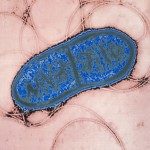Link to Pubmed [PMID] – 39413137
Link to DOI – 10.1073/pnas.2408509121
Proc Natl Acad Sci U S A 2024 Oct; 121(43): e2408509121
CRISPR-associated (Cas) endonucleases and their derivatives are widespread tools for the targeted genetic modification of both prokaryotic and eukaryotic genomes. A critical step of all CRISPR-Cas technologies is the delivery of the Cas endonuclease to the target cell. Here, we investigate the possibility of using bacterial conjugation to translocate Cas proteins into recipient bacteria. Conjugative relaxases are translocated through a type IV secretion system into the recipient cell, covalently attached to the transferred DNA strand. We fused relaxase R388-TrwC with the endonuclease Cas12a and confirmed that it can be transported through a T4SS. The fusion protein maintained its activity upon translocation by conjugation into the recipient cell, as evidenced by the induction of the SOS signal resulting from DNA breaks produced by the endonuclease in the recipient cell, and the detection of mutations at the target position. We further show how a template DNA provided on the transferred DNA can be used to introduce specific mutations. The guide RNA can also be encoded by the transferred DNA, enabling its production in the recipient cells where it can form a complex with the Cas nuclease transferred as a protein. This self-contained setup enables to target wild-type bacterial cells. Finally, we extended this strategy to the delivery of relaxases fused to base editors. Using TrwC and MobA relaxases as drivers, we achieved precise editing of transconjugants. Thus, conjugation provides a delivery system for Cas-derived editing tools, bypassing the need to deliver and express a cas gene in the target cells.


